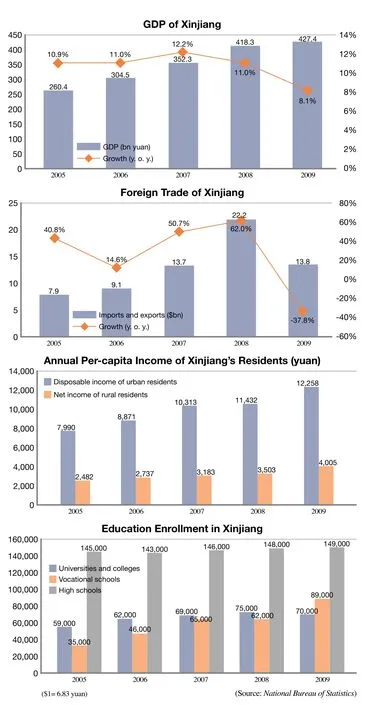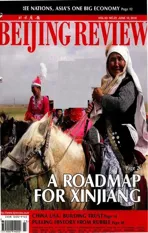Sources of Support
2010-10-14ByWANGJUN
By WANG JUN
Sources of Support
By WANG JUN
Xinjiang becomes the focus of a new development strategy to modernize and assist China’s western region
Not since the founding of New China in 1949 have Chinese policymakers gathered to discuss development and regional progress of Xinjiang. But recently, top leaders congregated to organize a progressive development scheme for China’s most western region.
“It laid out an all-embracing blueprint for Xinjiang’s future, and will play a signifcant role in boosting the region’s development, stability and the border area’s security,” said Hao Shiyuan, Director of the Institute of Ethnology and Anthropology of the Chinese Academy of Social Sciences, in a Xinhua News Agency report.
Support policies, such as a resource tax reform and partnership assistance program, were unveiled at the central work conference on Xinjiang’s development, held in Beijing on May 17-19, raising eyebrows among experts.
“The combination of three sources of support—Central Government support, assistance from economically developed regions, and Xinjiang’s self-development—demonstrates the spirit of unity and common endeavor. It will surely bring people of all ethnic groups in Xinjiang closer together,” said Hao.
Tang Yigai, a member of the advisor group of Xinjiang Uygur Autonomous Region, thinks the measures indicate the Central Government is resolved to improve its work in Xinjiang.
The pilot resource tax reform first launched in Xinjiang is signifcant.
The tax is important in propelling local economic development, said An Tifu, a professor of finance at the Renmin University of China, in an interview withThe Beijing News. Xinjiang has abundant oil and natural gas, but its location has restrained the region’s development.
A resource tax is a kind of local tax. Natural gas and oil taxed by price rather than by volume will surely increase local fiscal revenue, An said. These resources are mainly consumed in east China. A trial reform in Xinjiang can help narrow the income gap between Xinjiang and the eastern regions.
Tang also agreed. Infuenced by the global fnancial crisis and sharp decline of oil prices in the international market, many oilfelds in Xinjiang had reduced output of crude oil in 2009. The output was reduced from 27.22 million tons in 2008 to 25.18 million tons in 2009, Tang said. If taxes are levied on prices, the tax revenue for Xinjiang will increase by 10 billion yuan ($1.46 billion) every year.
Another preferential tax policy is for qualified enterprises in Xinjiang’s poor regions, which will be exempted from income taxes for two years and allowed a 50-percent reduction the following three years. Tang thinks that this will be conducive to promote development of private companies, especially small and medium-sized ones, to improve the investment environment and increase the income of Xinjiang residents. More importantly, this policy will be conducive to increase job opportunities.
As part of the support efforts, a partner assistance program will also be launched, with 19 provinces and cities participating.
The partner assistance program will surely bring opportunities to Xinjiang’s development, said Wei Houkai, Deputy Director of the Institute for Urban and Environmental Studies of the Chinese Academy of Social Sciences, in an interview withThe Beijing News. Accumulating financial aid worth 10 billion yuan ($1.46 billion) will not be diffcult for the 19 capital-rich regions. However, Wei insists that Xinjiang should establish a longterm mechanism to ensure sustainable growth, and cooperate with other regions.
“Besides the partner assistance program, all the ministries and commissions of the Central Government will also offer their support,” Tang said, when interviewed by China News Service. Tang said the Ministry of Education would spend 80 billion yuan ($11.71 billion) within fve years to improve the educational infrastructure in Xinjiang.
In an article written forCentury Weekly, Yu Jun, Executive General Manager of the Research Department of CITIC Securities Co. Ltd., said the Central Government has greatly supported the border areas and areas inhabited by ethnic minorities. Yu thinks addressing the need to enhance Xinjiang’s internal economic development impetus is the key point of the conference.
Now that the conference has concluded, many infrastructure projects and projects related to people’s livelihood will be launched. Yu anticipates that the Central Government will continue to strengthen the investment in infrastructure projects in Xinjiang—mainly housing development in south Xinjiang and power grids and railways that can ensure energy transmission.

ZHANG KAIXIN

CFP
The central work conference on Xinjiang stated more fscal resources to the public service sector and to the projects with signifcant public interest were required. Yu thought this was a means for the government to shift away from its former subsidy-oriented supporting pattern.
Construction of these infrastructure projects will not only drive demand of some related industries, but will also promote the development of some industries, such as potash fertilizer and coal, the expansion of which was restricted by the underdeveloped transport facilities.
In anotherCentury Weeklyarticle, Lei Yao, a researcher at the Research Bureau of the People’s Bank of China, thought the new policies are not only conducive to the development of Xinjiang, but also of practical signifcance to the whole country in three aspects.
Revamping the resource tax can frst of all enhance the local financial strength of Xinjiang, while a more reasonable mechanism for resource utilization may provide a catalyst to transfer resource advantages into industrial advantages. The resource tax revamp is conducive to effciently and intensively utilizing Xinjiang’s rich resources. It can also be anticipated that the achievements in Xinjiang during the revamp trials will inevitably help to increase the effciency of resource development, allocation and utilization throughout the whole country.
China is currently formulating general ideas and policies to deepen the Western Development Strategy over the next decade, and by strengthening the opening up process in Xinjiang, the country may fnd a unique way of continuing such efforts on a course different from the opening up of the eastern region.
To implement the new measures to boost development in the autonomous region, Xinjiang needs to make full use of the principal role of the market in resource allocation and be able to develop through economic and technological cooperation with other provinces, autonomous regions and municipalities.

